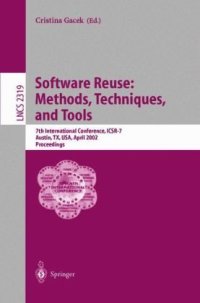
Ebook: Software Reuse: Methods, Techniques, and Tools: 7th International Conference, ICSR-7 Austin, TX, USA, April 15–19, 2002 Proceedings
- Genre: Education // International Conferences and Symposiums
- Tags: Software Engineering, Management of Computing and Information Systems, Programming Techniques
- Series: Lecture Notes in Computer Science 2319
- Year: 2002
- Publisher: Springer-Verlag Berlin Heidelberg
- Edition: 1
- Language: English
- pdf
As a result of the open-source movement there is now a great deal of reusable software available in the public domain. This offers significant functionality that commercial software vendors can use in their software projects. Open-source approaches to software development have illustrated that complex, mission critical software can be developed by distributed teams of developers sharing a common goal. Commercial software vendors have an opportunity to both learn from the op- source community as well as leverage that knowledge for the benefit of its commercial clients. Nonetheless, the open-source movement is a diverse collection of ideas, knowledge, techniques, and solutions. As a result, it is far from clear how these approaches should be applied to commercial software engineering. This paper has looked at many of the dimensions of the open-source movement, and provided an analysis of the different opportunities available to commercial software vendors. References and Notes 1. It can be argued that the open-source community has produced really only two essential 9 products -- Apache (undeniably the most popular web server) and Linux although both are essentially reincarnations of prior systems. Both are also somewhat products of their times: Apache filled a hole in the then emerging Web, at a time no platform vendor really knew how to step in, and Linux filled a hole in the fragmented Unix market, colored by the community s general anger against Microsoft. 2.Evans Marketing Services, Linux Developers Survey, Volume 1, March 2000.
This book constitutes the refereed proceedings of the 7th International Conference on Software Reuse, ICSR-7, held in Austin, Texas, USA, in April 2002. The 22 revised full papers presented together with summaries or abstracts of keynotes, workshops, and tutorials were carefully reviewed and selected from numerous submissions. The papers are organized in topical sections on implementation, product lines, managerial and economic issues, generators, reuse of non-code artifacts, and design issues. The book contributes to bridging the gap between industrial practice and academic research and development in the area.